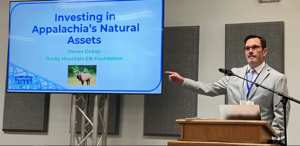Hunters, anglers, hikers and others who enjoy the outdoors in the Appalachian Region will soon be able to access much more of it. Why? It’s because of hunters and hunter-based organizations like the Rocky Mountain Elk Foundation.
RMEF is working closely with The Nature Conservancy (TNC) and the Kentucky Department of Fish and Wildlife Resources (KDFWR) to establish the C. F. Ataya voluntary conservation agreement (conservation easement) that will create nearly 55,000 acres (see above photo) of perpetual public access in Kentucky’s elk zone.
“This easement will protect critical habitat from industrial development, while permitting landowners to generate revenue from natural resources interests such as timber, natural gas, and carbon projects,” said Steven Dobey (see photo below), RMEF senior conservation program manager for the eastern U.S.
Dobey and partners from TNC and Breaks Interstate Park recently spoke at the Appalachian Regional Commission’s annual conference in Ashland, Kentucky. Among other things, they focused on the economic benefits of hunting and outdoor recreation, and how the restoration of elk in the Appalachian region helped opened the door for landscape-scale public access projects.
RMEF, with its hunter-based membership of 225,000, supplied financial and volunteer support leading to the successful restoration of elk to their historic range in Kentucky (1997), North Carolina (2001), Tennessee (2000), Virginia (2012) and West Virginia (2016), and more funding to enhance habitat for elk, deer, bears and other wildlife since then.
Dobey quoted a recent KDFWR survey that estimated elk hunting alone had a $3.1 million impact in Kentucky in 2022. The nationwide impact is also noteworthy.
“Southwick and Associates documented that recreational hunters and sport shooters contributed $149 billion to our national economy in 2020, with hunters accounting for 74 percent of these economic contributions,” said Dobey. “Likewise, this economic assessment found that hunting supported nearly 970,000 jobs in the U.S. and created more than $49 billion in wages and income in 2020.”
And hunter support was key to acquiring the necessary funding for the Ataya project. Partners secured more than $14 million in 2022, including more than $9 million in Pittman-Robertson funds (federal excise taxes on guns, ammunition and archery equipment) via KDFWR. The Kentucky legislature also made a one-time allocation of $3.875 million that same year. And RMEF secured a $650,000 grant from the National Fish & Wildlife Foundation.
“This project, years in the making, is a public access success story that may never again be rivaled in Kentucky. And it would not have been possible without the perseverance of all partners,” added Dobey.
(Photo credit: Ben Childers & Sally Palmer/The Nature Conservancy)
